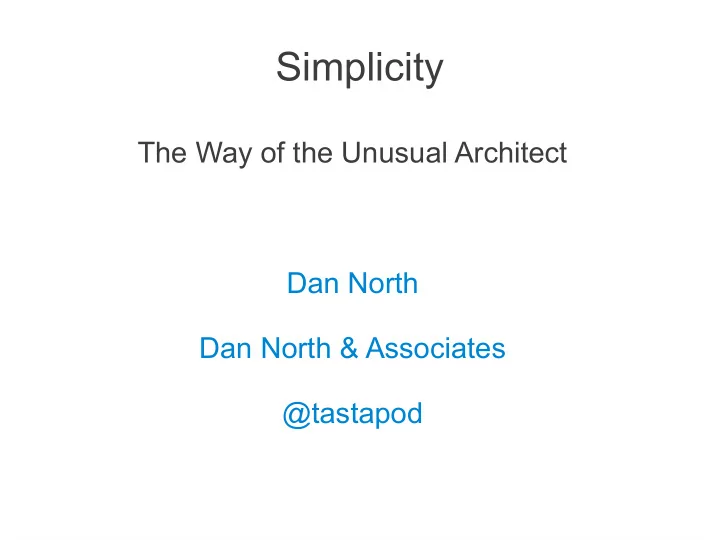

Simplicity The Way of the Unusual Architect Dan North Dan North & Associates @tastapod
In the beginning... The software was without form and void. The Architects said “Let there be light,” and they separated the light from the darkness. And they called the light Architecture and the darkness Hacking. And that was the first project
On the second project... The Architects used all the technologies of the heavens and the earth they hadn’t got round to the first time The simple new() was replaced by a Factory which was replaced by Dependency Injection which was replaced by an IoC Container which was augmented by XML configuration which was supplemented by @nnotations
But they were not done yet... The simple save() was replaced by a DAO which was replaced by a Unit of Work pattern which was replaced by a custom ORM which was replaced by Hibernate which is called NHibernate by the Redmondites which was eventually replaced by a Document Database* so that the people might call it Web Scale *some translations say “Graph Database” for verse 94
And still they toiled... The simple compile was replaced by a Makefile which was replaced by an Ant build.xml which is called NAnt by the Redmondites which was replaced by many build.xml files which were generated by an XSL transform which was replaced by Maven And Maven brought forth a Plague of Apache Commons, and there was a flood of all the Libraries of the Internet as a judgement upon the people. And that was the Second System
The Architects were fruitful and multiplied They decided to build an Architecture that would reach to the very Heavens, to show how clever and wise they were, and Distributed Systems would be its name But it came to pass that they were scattered to the four winds and began to speak in different tongues Some spoke in CORBA, which was called DCOM by the Redmondites. The Sunnites – who would one day be swallowed up by the mighty Whale of the Oracle – spoke in the tongue of JNDI, which was XMLish and verbose And there was a plague of standards to test the people
These are the generations of Distributed Systems... RPC produced RMI which produced COM and Object Brokers COM produced DCOM, which produced WCF Object Brokers produced Web Services Web Services married XML and they had two sons, and SOAP and WSDL were their names SOAP produced the twelve (hundred) tribes of WS-* WSDL produced Code Generated Stubs and the Abstractions did Leak forth upon the Software And the people wrung their hands and wept
On the seventh day, they RESTed
The same story happens over and over 1. We observe a repeating phenomenon 2. We create abstractions 3. The abstractions become a framework 4. People start to subvert the framework 5. Finally, sometimes, simplicity grows out of adversity Why do we keep doing this?
This is a pair of three-quarter circles http://www.flickr.com/photos/davidjoyner/2491859887/
We are programmed to see structure The Fifth Discipline Field Book – Peter Senge
We choose to optimize for generality or flexibility or reuse or cost-per-use Some people, when confronted with a problem, think “I know, I'll use regular expressions.” Now they have two problems. - Jamie Zawinski, 1997 We complify where we should simplicate
How can we get out of this mess? “My name is Dan, and I'm a complexaholic” Identify accidental complexity – Ask: What is this for? Use time-boxes to challenge your progress – Ask: How else? Who else? Simplicity is different from familiarity – Ask: What really matters here?
“If I were going to Dublin...” Question every dependency Pull value rather than pushing a solution Ask: What is actually slowing me down? Get a pair. Or a bath duck.
We tend to solve the wrong problem What is the first-order problem when we are: - clustering state across application instances - using a business modeling tool - using Maven - using an Object-Relational Mapper
Solve the right problem Simplicity leads to adaptability Defer decisions to create options Have a roadmap “Maximize the work not done” - Kent Beck
Conclusion We are programmed to complify The real goal is to simplicate Always assume there is a simpler way
Thank you dan@dannorth.net http://dannorth.net @tastapod http://www.flickr.com/photos/nicksieger/280661836/ http://www.flickr.com/photos/nicksieger/281055485/
Recommend
More recommend